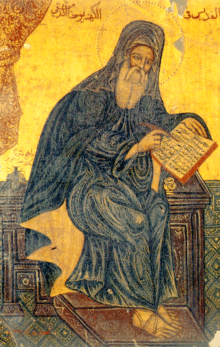John of Damascus
Christian monk, priest, hymnographer and apologist (675/6-749)
(Redirected from John Damascene)
Saint John of Damascus (Arabic: يوحنا الدمشقي Yuḥannā Al Demashqi; Greek: Ιωάννης Δαμασκήνος (Iôannês Damaskênos); Latin: Iohannes Damascenus; also known as John Damascene, Χρυσορρόας/Chrysorrhoas, "streaming with gold"—i.e., "the golden speaker") (c. 676 – 4 December 749) was a Syrian Christian monk and priest. Born and raised in Damascus, he died at his monastery, Mar Saba, near Jerusalem.

Sourced
edit- In the relics of the saints the Lord Christ has provided us with saving fountains which in many ways pour out benefactions and gush with fragrant ointment. And let no one disbelieve. For, if by the will of God water poured out of the precipitous living rock in the desert, and for the thirsty Sampson from the jawbone of an ass, is it unbelievable that fragrant ointment should flow from the relics of the martyrs? Certainly not, at least for such as know the power of God and the honor which the saints have from Him.
- In Saint John of Damascus: Writings (The Fathers Of The Church A New Translation Vol. 37), 1958, 1999, Frederic H. Chase, Trans.
- Alternate translation: Christ gives us the relics of saints as health-giving springs through which flow blessings and healing. This should not be doubted. For if at God’s word water gushed from hard rock in the wilderness-yes, and from an ass’s jawbone when Samson was thirsty -why should it seem incredible that healing medicine should distill from the relics of saints
- In Relics: The Shroud of Turin, the True Cross, the Blood of Januarius: History, Mysticism, and the Catholic Church, by Joan Carroll Cruz, 1984 , p. 37.
- The Christianocategori, or Accusers of Christians, are such and are so called, because those Christians who worship one living and true God praised in Trinity they accused of worshiping as gods, after the manner of the Greeks, the venerable images of our Lord Jesus Christ, of our immaculate lady, the holy Mother of God, of the holy angels, and of His saints.They are furthermore called Iconoclasts, because they have shown deliberate dishonor to all these same holy and venerable images and have consigned them to be broken up and burnt.
Likewise, some of those painted on walls they have scraped off, while others they have obliterated with whitewash and black paint. They are also called Thymoleontes, or Lion-hearted, because, taking advantage of their authority, they have with great heart given strength to their heresy and with torment and torture visited vengeance upon those who approve of the images.- On Heresies.
- In, Saint John of Damascus: Writings (The Fathers of the Church, Vol. 37), 1958, 1999, Frederic H. Chase, Trans. p. 160
- Images are books for the illiterate and silent heralds of the honor of the saints, teaching those who see with a soundless voice and sanctifying the sight.
- "Defense against those who attack the holy images," as translated by Andrew Louth, Three Treatises on the Divine Images, (Saint Vladimir’s Seminary Press: 2003) p. 46